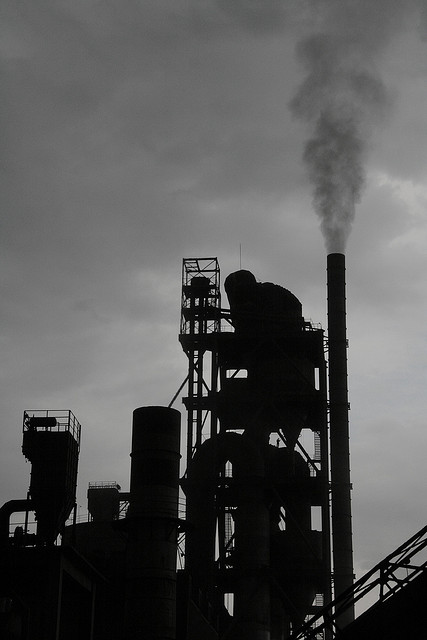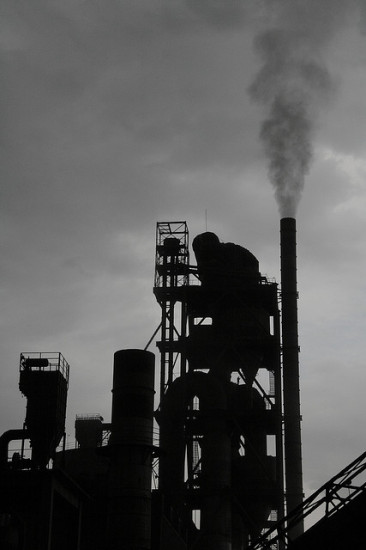In the last 20 years, we’ve learned more and more about air pollution from Asia that blows across the Pacific Ocean and falls out of the atmosphere here in the Northwest.
Scientists have estimated that nearly one-fifth of the mercury in the Willamette River comes from foreign sources, much of it from China. Dust from storms in the Gobi desert can turn local skies milky white. When winds blow from Asia, pristine mountaintops like Mount Bachelor and Cheeka Peak on Washington’s Olympic Peninsula see increased levels of industrial chemicals that contribute to smog and can pose other health risks. (For a great overview, just read this story from Discover Magazine.)
But a recent study poses an interesting question, particularly in light of efforts to block Northwest coal export terminals: How much of the industrial pollution we get from fossil fuels burned in China is arguably because of us?
Specifically, the study published late last year in the Proceedings of the National Academy of Sciences (PNAS) estimates how much US pollution can be attributed to fossil fuels (largely coal) that are burned in China to produce the clothes, electronics, toys, furniture, and other manufactured goods that are consumed in other countries?
In Washington and Oregon, for instance, these published maps estimate that on the most polluted days in 2006, China’s export-related emissions contributed roughly between 12 and 20 percent of the region’s sulfate pollution, which can aggravate respiratory problems and acid rain. The contribution was between roughly 2 to 4 percent for ozone pollution in the Northwest, up to 10 percent for black carbon and between 4 and 5 percent for carbon monoxide.
Of all those export-related emissions, roughly 21 percent are attributable to goods that are bought and consumed in the United States, according to the study.
If one takes all of China’s air pollution into account—not just the trade-related emissions—the local contributions in 2006 would be roughly three times higher for SOx and NOx and four times higher for black carbon.
It’s important to keep in mind that these pollution estimates are based on models that carry high levels of uncertainty. So on some level, the actual numbers may matter less than the larger point, which is that a significant portion of the coal being burned in China (and the resulting emissions) is being driven by the consumption of goods in the US and elsewhere. While China can pursue cleaner alternatives, its appetite for energy—of all sorts—remains connected to the things that we buy.
How the pollution gets here
Coal combustion produces carbon dioxide, which generally joins a global pool of climate-warming gases that blanket and circle the planet. It also releases a number of shorter-lived chemicals that can fall back to earth as local pollution, including nitrogen oxide (NOx), sulfur oxide (SOx), carbon monoxide, particulate matter (including black carbon), and trace metals such as mercury. Those pollutants can make soils and lakes more acidic, contribute to smog, harm human tissues and hearts, increase risks of respiratory and neurological problems, and damage crops.
In China, pollution problems are compounded because the combustion efficiency of coal burned there is relatively low and emission controls are relatively weak. The growing volume of Chinese exports, which according to the PNAS study rose by 390% from 2000 to 2007, has led to increases in those pollutants.
But whether or not those pollutants get transported from China all the way to the US depends on a number of factors: They have to be injected high enough into the atmosphere to get picked up by the jet stream, they have to avoid getting rained out or chemically altered along the way, and they have to be propelled across the Pacific Ocean by vigorous winds. That’s why pollution transport tends to be sporadic, though it typically peaks in spring when under favorable conditions the journey from Asia to the US west coast takes 5 to 7 days.
In fact, because shorter-lived pollutants are more likely to get deposited near a Chinese smokestack than get carried along the jet stream across the Pacific, China’s residents bear a much greater pollution burden from our consumption-based emissions, as these maps from the PNAS results show. (Note: these ranges are based on average annual concentrations rather than worst-case pollution days.)
Embodied emissions
The PNAS study, which was authored by researchers in China and the US, only counted emissions that are related to the energy required to manufacture export goods for and excludes pollution from traffic, coal dust, home heating, etc. Because coal burning provides nearly 70 percent of China’s energy, a large fraction of those emissions must be from coal.

Made in China by Maithri, flickr used under CC CREATIVECOMMONS.ORG licenses
The emissions ’embodied’ in the goods we buy from China are emissions we would be producing in the US if those goods had been manufactured here. Outsourcing that manufacturing makes our own atmosphere cleaner than it would otherwise be. In fact, these maps estimate that some areas of the East Coast have seen reduced pollution as a result of importing Chinese goods.
Here in the Northwest, where we’re more likely to see local fallout from China’s emissions, the opposite is more likely to be true, according to the study maps. So how much of a difference does that additional pollution make?
The modeling study, at least, suggests that right now, the export-related pollution from China is probably contributing a relatively small share of the Northwest’s local pollution. If you consider the local impacts from China’s total emissions—not just the trade-related ones—that overseas pollution starts to become more significant. And as China’s emissions continue to grow, it could become harder for some West Coast cities to meet federal air quality standards over time.
But the larger point embedded in the study is perhaps even more relevant, given the multiple proposals to turn Northwest ports and shorelines into loading docks for China’s fossil fuels. We shouldn’t ignore that part of the demand for that coal (overstated though it may be) is fueled by the iPads, bicycles, sneakers, and countless other things we buy and the the dynamics that make it so much cheaper to manufacture them overseas.










SteveG
Recalls the old cartoon:
http://www.igopogo.com/we_have_met.htm
Ray Kinney
It’s all well and good to study and complain about Asian pollution while we ‘stick our heads into the sand’ while fishing on our salmon streams with lead fishing sinkers that get lost at the rate of tons per year into our salmon streams. We pollute our hands with lead particulate before eating our lunches, we handle our fish and contaminate their mucus, we carry this pollution into our frying pans and into our families at home… all supported by fishing regulations that serve to enable our pollution. None of this shows up on state reporting to the EPA for Clean Water Act 303d or other toxic pollution reporting processes. We allow publically-owned railroad bridges to drop degrading lead paint into our salmon streams at high rates even while we try to get more salmon to return to catch (at the cost of many millions of dollars per year). We poison what we love. Crematoria release huge quantities of volitalized mercury from dental amalgam. We had better pull our heads out of the sand if we want to focus on Asian pollution heading for our NMBY backyards.
David Moore
Good focus on lead pollution and we should ban lead fishing weights, ammunition and paint. USFWS has begun to ban lead shot in federal refuges. Is there a WA state campaign? Maybe Audubon society would be a good ally.
David Moore
Chinese coal pollution, Chinese industrial spying,poor Chinese enforcement of endangered species importation, Chinese unfair trade policies and poor labor protection laws should all be addressed through preparing a large boycott or official government embargo. Without a strong message China will not change practices. If we continue to buy these goods we are the problem as you say.
Vernon Huffman
I suspect Walmart is the biggest importer to the US of Chinese goods for retail. There are lots of other reasons to boycott a company that abuses their workers, competes unfairly against small businesses, and sells low grade products.
Charlie Weiss
The article didn’t quite come back around to our coal exports. My take: Seems that (all) power generators buy the cheapest fuel they can find. If we don’t sell them our coal (which is pretty cheap), coal (and other energy) will cost more, so the cost of making our goods will go up, and things might slowly equalize. If this idea holds water, it could offer a compelling reason NOT to sell our coal abroad.
Vernon Huffman
Coal from the Powder River Basin in Wyoming & Montana is a particularly dirty sub-bituminous grade. One reason they want to export it is that US regulations make it hard to burn here.